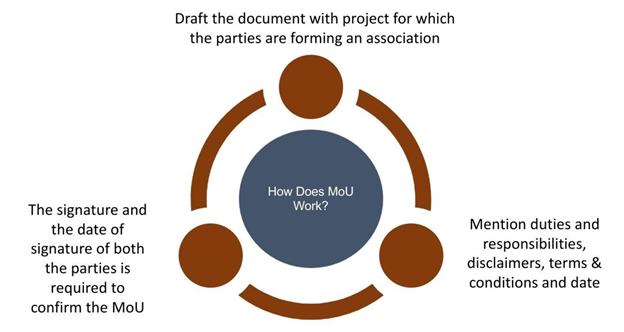Definition
Related Definitions
Memorandum of Understanding (MOU)
What is a Memorandum of Understanding (MOU)?
A memorandum of understanding (MOU) is a document that expresses mutual accord between two or more parties. MOU is not a legal contract, but is can be recognized as binding on the rights and obligations mentioned in it.
It is more of a formal agreement between two or more parties and proof of their commitment to each other. MOU has been commonly opted when the parties do not want the deal to face any compulsion by law.
However, if any legal elements are mentioned in the memorandum of understanding, then the parties have to abide by it as well.
The signing of the contract showcases the willingness of the parties to move ahead and start the work/project.
Usually, in a memorandum of understanding, the details of the contracting parties and the subject matter of the agreement along with parties’ deliverables are noted.
The basic terms of the document are agreed, and the parties should sign it in order to make it mutually binding. Memorandum of Understanding starts as an initiation for negotiations. It states the scope and purpose of the negotiations talks, and it defines an intended standard line of action.
Many private and public companies, as well as government agencies, use MOU to initiate a process.
What is the Difference between MOU and Other Agreements?
The agreement is a document parties accept to work together on a project or standard work process. It contains a proposal and its acceptance by the parties involved. If anyone party breaks the terms and conditions of the agreement, the other party can go to the court and get it enforced.
At the same time, Memorandum of Understanding MOU is where both the parties propose their common intent and commit to it in the future. It is not a valid or a legal contract.
How Does a Memorandum of Understanding Work?

Image Source : © Kalkine Group
What are the Salient Features of Memorandum of Understanding?
- MOU is an expression of a contract for the parties involved in it to proceed. It indicates that the parties have come to a conclusion after the negotiations. It expresses that the parties have reached final understanding of the agreement and are ready to move forward to implement it.
- Although the MOU is not legally binding, it is a solemn declaration of the commitment between the parties.
- Typically, the MOU consists of the parties to the contract and the work process for which the parties are outlining the agreement.
- It also states the period, start and end date of the project for the deal to be functional.
- The deliverables from both sides of the agreement are clearly stated in the MOU along with well-defined disclaimers.
- It has terms and conditions and details of the agreement such as the objective, deliverables, fees etc. It mainly focuses on mutual understanding between two parties’ requirements and responsibilities.
- The financials involved in the deal are also mentioned in the agreement.
- Another essential aspect of the MOU is the memorandum of understanding notes the risk-sharing by both the parties.
- The legal team in the company usually designs the draft and once it is agreed by both the parties, the signature and date of the signature is the final step to confirm the content mentioned in the memorandum of understanding.
What are the Advantages of MOU?
Primary advantage MOU offers is that the obligation under international law could be avoided. MOU can be approved and implemented without legislative approval. They are often used to modify existing government treaties.
For businesses as well, it does not hold any legal authority unless mentioned in the document. These documents are drafted with transparent terms and conditions for both the parties to abide, along with both parties’ roles and responsibilities. Hence it makes it very clear before proceeding for a project.
Both parties have explicit knowledge of their deliverables and also consequences. For instance- Party 2 will have to reprint the marketing collaterals if they have misused Party 1 logos.
How is MOU Used in International Public Law?
In international affairs, MOU comes under the category of treaties. A memorandum of understanding is registered in the United Nations Treaty Collection. The United Nations Office of Legal Affairs insists that the registration should be done. Though MOU's are sometimes labelled as confidential documents, the practice in the UN is followed to avoid any secret diplomacy.
In order to understand the legality of the documents, it is vital to understand the content mentioned in the treaty to understand the exact nature of the treaty and see which signatories position hold what legal status. Such as Minister of Foreign Affairs will bear the signature differently than the Minister of Environment.
A careful examination of the document will also explain the intent of it. The International Court of Justice has provided some insights in the past to understand the legal status of the memorandum of the understanding document (treaty).
Are there Any Risks Associated with MOU?
Not everyone agrees that the MOU is beneficial. In the event of discrepancy between the parties, MOU terms may lead to inefficient discussion and uncertain settlement outcomes in case the language and content do not indicate clear plan of action.
